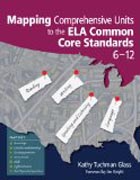
Mapping Comprehensive Units to the ELA Common Core Standards, 6-12
Glass, Kathy Tuchman
Your ELA roadmap to achieving Common Core objectives! Are your secondary students on track to meet the new Common Core ELA standards? If they aren’t, they can be soon. In Mapping Comprehensive Units, Kathy Glass presents a comprehensive plan for effective curriculum design that you can use as a model for either revising your existing Grades 6-12 ELA curriculum or creating an entirely new one. This book includes: Key benefits and a rationale for each standard Tools for developing a unit map and reinforcing important connections across all components Practical instruments to plan exciting, content-rich Common Core units of study INDICE: List of FiguresForewordAcknowledgmentsAbout the AuthorIntroductionChapter 1: Standards and Knowledge The Purpose of Standards Key Areas of Emphasis in the ELA Common Core Standards Understanding Fiction and Nonfiction Characteristics Definitions of the Common Core Text Types and Sample Prompts What Do Argument Texts Entail? What Do Informative/Explanatory Texts Entail? What Do Narrative Texts Entail? A Closer Look at Appendix C: Samples of Student Writing Identifying and Articulating the Language Standards Across Grades Exercise 1: What Is the Best Way to Group Standards? Unit Focus and Template Considerations for Grouping Standards Grouping Standards: Two Approaches Definition and Examples for Knowledge Exercise 2: How Are Standards Used to Determine What Students Should Know? Looking AheadChapter 2: Essential Understandings The Nature and Critical Importance of Essential (or Enduring) Understandings Essential Understandings as Statements of Conceptual Intent Examples of Essential Understandings Aligned to the Anchor Standards for Reading Special Considerations: Time, Intellectual Growth, Clustering Constructing Your Own Essential Understandings Exercise 3: How Do Educators Create (or Revise) Essential Understandings? Sharing Essential Understandings With Your Students Looking AheadChapter 3: Guiding Questions The Importance of Guiding Questions Sharing Guiding Questions With Your Students The Differences Between Essential Unit and Lesson Guiding Questions Designing Text-Dependent Questions for Complex Text How Do Teachers Facilitate Close Reading of Complex Texts? Examples of Essential Unit and Lesson Guiding Questions for Grammar and ConventionsConstructing Your Own Essential Unit and Lesson Guiding Questions Exercise 4: How Do Educators Create (or Revise) Essential Unit and Lesson Guiding Questions? Looking AheadChapter 4: Unit Map Template and Example Customizing and Adapting the Unit Map to Fit Your Needs Organizing Unit Maps and Student Work Looking AheadChapter 5: Summative Assessments and Preassessments Types of Assessments Summative (Culminating) Assessments Rubrics Checklists Preassessments Constructing Your Own Summative Assessment Exercise 5: How Do Educators Determine an Appropriate Summative Assessment? Looking AheadChapter 6: Skills, Activities, Formative Assessments, and Resources Skills Teaching Strategies and Learning Activities Formative Assessments Resources Identifying Skills and Constructing Activities, Evidence of Assessment, and Resources for Your Targeted Unit Exercise 6: What Targeted Skills With Associated Activities, Evidence of Assessment, and Resources Can Educators Design (and Find) for a Targeted Unit? Looking AheadChapter 7: Differentiated Instruction Content, Process, and Product Readiness, Learning Profile, and Interest Instructional Strategy: Rolling Dice or Cubes Instructional Strategy: Using Manipulatives Constructing Your Own Differentiated Instructional Strategies Exercise 7: How Can You Indicate Differentiation on Your Unit Map? Looking AheadChapter 8: Lesson Design Lesson Components Sample Lessons Next Steps After Designing Lessons A Final Note Lesson 1: What Are Inferences? How Do I Make Inferences About This Text? Lesson 2: What Is Characterization? How Do Authors Use Characterization to Create and Develop Characters? Lesson 3: What Factors Help Me to Evaluate the Credibility of Sources? Lesson 4: What Are Elements of an Argument Paper? What Are the Expectations for My Finished Argument?Resource: A Brief Primer on the ELA Common Core Standards Creation and Purpose of the Common Core Standards Who Led the Standards Initiative, and What Is the Goal? Who Are the CCSSO and NGA? Content and Structure of the Common Core Standards Research Highlights for the Reading Strand Logistics Can States Add to the Standards? How Can Standards Be Identified? Collaboration, Limitations, and Assessment Who Uses These Standards Besides the ELA Teacher? What Aspects Are Not Covered in the Common Core Standards Document? What to Look for When Aligning Existing Standards With the Common Core Assessments ClosingReferencesIndex
- ISBN: 978-1-4522-6862-0
- Editorial: Corwin
- Encuadernacion: Rústica
- Páginas: 288
- Fecha Publicación: 16/07/2013
- Nº Volúmenes: 1
- Idioma:
